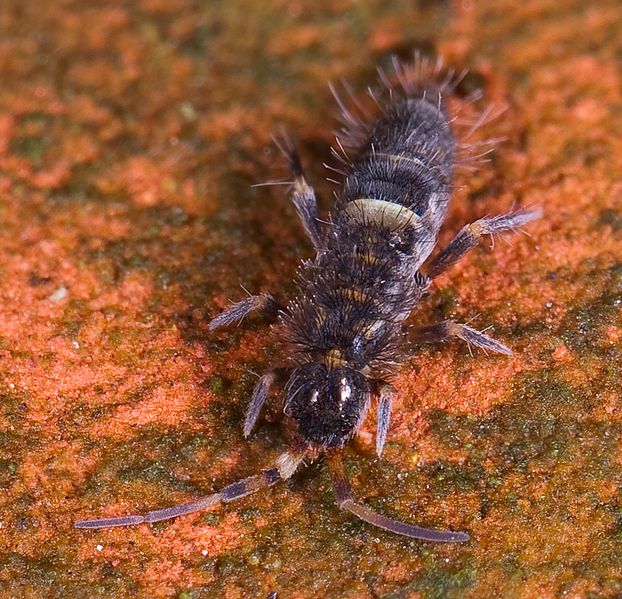 Springtails are minute, primitive, wingless insects classified in the Order Collembola. Over 6,000 species are found in most temperate and tropical habitats, where they figure importantly in the diets of Poison Frogs (Dendrobates, Phyllobates, Oophaga), small salamanders and newly metamorphosed amphibians of many kinds. Please see Part I of this article for information on procuring Springtails and their role in helping to save the nearly extinct Kihansi Spray Toad (Nectophrynoides asperginis). Read More »
Springtails are minute, primitive, wingless insects classified in the Order Collembola. Over 6,000 species are found in most temperate and tropical habitats, where they figure importantly in the diets of Poison Frogs (Dendrobates, Phyllobates, Oophaga), small salamanders and newly metamorphosed amphibians of many kinds. Please see Part I of this article for information on procuring Springtails and their role in helping to save the nearly extinct Kihansi Spray Toad (Nectophrynoides asperginis). Read More »
Tag Archives: springtails
Feed SubscriptionRaising Springtails as Food for Poison Frogs, Mantellas and other Small Amphibians – Part 1
 The diets of captive Poison Frogs (Dendrobates, Phyllobates, Oophaga), Mantellas, small salamanders (i.e. Red-Backed Salamanders) and tiny, newly-transformed amphibians are usually limited to the two readily available foods of appropriate size – pinhead crickets and fruit flies. The minute, wingless insects known as Springtails (Order Collembola) are easy to procure and rear, and offer a convenient means of increasing dietary variety for small amphibians.
The diets of captive Poison Frogs (Dendrobates, Phyllobates, Oophaga), Mantellas, small salamanders (i.e. Red-Backed Salamanders) and tiny, newly-transformed amphibians are usually limited to the two readily available foods of appropriate size – pinhead crickets and fruit flies. The minute, wingless insects known as Springtails (Order Collembola) are easy to procure and rear, and offer a convenient means of increasing dietary variety for small amphibians.
Natural Diets of Smaller Amphibians
Most small terrestrial frogs and salamanders forage among leaf litter, which is invariably inhabited by thousands of species of tiny invertebrates (surprisingly, the weight of invertebrates in most habitats exceeds that of all vertebrates combined!). It seems certain that these amphibians consume an extremely varied diet in the wild, and that typical captive diets do not meet their nutritional needs.
Aphids (1/8-inch-long green or red insects found in colonies on plant stems) are an option, but these are becoming scarce in many areas and, with their complicated life history (involving sex-switching and other unique twists), are difficult to maintain long-term. One can also collect ants, tiny beetles and other leaf litter invertebrates (please see article below), but of these only Springtails can be easily bred in large numbers.
Problematical Captives
 Some amphibians are so small that even pinhead crickets prove too large a meal. I’ve run into this situation with Kihansi Spray Toads (Nectophrynoides asperginis), which are a mere ¾ inch long when full grown. These toads, now likely extinct in the wild, give birth to fully formed toadlets that are so small as to be barely visible. A steady supply of Springtails was essential to the successful rearing of these Tanzanian natives, the last of their kind on earth. Folks breeding other tiny amphibians, such as Strawberry Poison Frogs (Oophaga pumilio), will also find Springtail colonies an invaluable resource.
Some amphibians are so small that even pinhead crickets prove too large a meal. I’ve run into this situation with Kihansi Spray Toads (Nectophrynoides asperginis), which are a mere ¾ inch long when full grown. These toads, now likely extinct in the wild, give birth to fully formed toadlets that are so small as to be barely visible. A steady supply of Springtails was essential to the successful rearing of these Tanzanian natives, the last of their kind on earth. Folks breeding other tiny amphibians, such as Strawberry Poison Frogs (Oophaga pumilio), will also find Springtail colonies an invaluable resource.
Procuring Springtails
With over 6,000 species identified thus far, Springtails are common in most temperate and tropical habitats. They usually appear as tiny white “dots” jumping about below fallen leaves. You can start a colony by scooping them up in the leaf litter or by purchasing any of the several species available through commercial suppliers. Most breed well in captivity and can build up enormous populations under favorable conditions – please see Part II of this article for details.
Further Reading
Whenever possible, the diets of smaller amphibians should be supplemented with wild-caught invertebrates. Please see Collecting Leaf Litter Invertebrates for some useful techniques.
Strawberry Poison Frog image referenced from wikipedia and originally posted by Encarna Sáez Goñalons & Víctor Martínez Moll
Springtail image referenced from wikipedia and originally posted by Mvuijlst
 That Reptile Blog – Reptile, Amphibian and Exotic Pet Care and Information
That Reptile Blog – Reptile, Amphibian and Exotic Pet Care and Information
